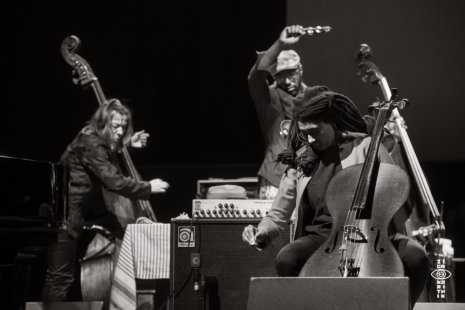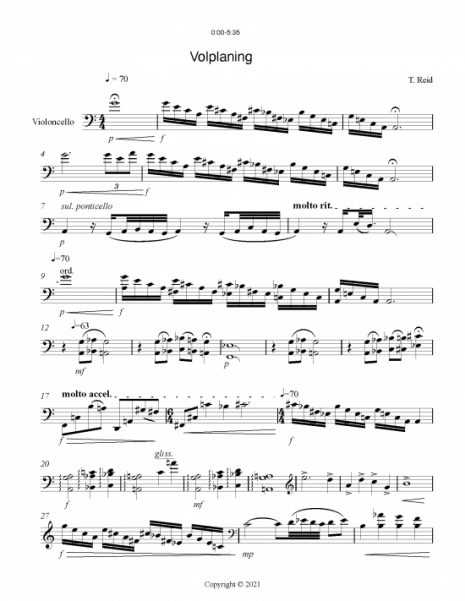In Tomeka's Words...
My musical journey began in Chicago in 2000. Green and curious, I moved to the windy city via Greyhound for graduate studies in a classical performance degree program knowing full well I had other ambitions but didn’t yet have the courage to take the leap of faith into what seemed like so much uncertainty. That fall I connected with several musicians outside of school whom I remain closely linked to musically until this day. While I had dabbled into improvisation prior to my move, Chicago clearly marked the beginning of my current path.
For more than 10 years, working in several ensembles as a side person throughout the city, I honed my voice on the cello. Finding myself often in more freely improvised situations, I fell in love with exploring sound and rhythm.
As a result, I began to create work that was stringed instrument centered (in alignment with my preference to perform acoustically) and combined elements that I most enjoyed from the different musical settings in which I performed. Influenced by members of the Chicago-founded, historic and genre-flexing organization, the Association for the Advancement of Creative Musicians, as well as the current creative music scene, my work and approach to composition and improvisation reflects my exposure to this rich musical environment.
The compositions I write combine my love of the in and out, of melody and cacophony. I believe that these elements are a direct reflection of our everyday life and can exist harmoniously. Often my compositions pay tribute to people that have impacted me personally and/or musically such as cellist, Abdul Wadud and violinist, Billy Bang, two great innovators in string improvisation. I thoroughly enjoy the improvisatory element that brings this music alive, with performers reacting to each other and audience members witnessing the formation of spontaneous arrangements, creating an energy that becomes a part of the overall composition.
In this current moment, there are still many concerns. Planning for the future continues to feel uncertain although there is a bit more hope than in 2020. Online performances will be a part of our futures. While I still don’t completely enjoy the format particularly in an art form whose backbone rests on the interaction between players, the energy from audiences and the rooms themselves, we are improvisers and with that comes the innate ability to adapt and be flexible.
My short-term goals include planning for what will now be the 8th edition of the Chicago Jazz String Summit. This event is a labor of love as it is primarily self-funded. For the second year in a row, we have shifted to an online model and will most likely continue in that way in addition to live sets, should it be possible to have them in May of 2022. Having the event online allowed for more overall visibility of the event and for many to see the program from around the world.
As much as I love composing and performing, the older I get the more I realize the importance of writing about the music I am intimately involved with from a black, female practitioners’ perspective. I feel that it is crucial that we tell our stories and when possible use our platform to share the stories of others. Too often, stories are left out of conversations, with relevancy decided upon by a just a few voices.
Recently, I received funding for a project that will document and celebrate the women of the AACM and their contributions in a book form. I am also in conversation with Taylor Ho Bynum to create a jazz textbook that we feel represents the landscape of this wondrous music. As educators, we have been dissatisfied with some of the available sources for students to absorb the music’s complex history.
Plans to record my large ensemble project have been postponed due to our current COVID crisis. However, this will allow me time to create more sections for the work based on my mother’s paintings. The project has been presented at Roulette and the University of Maryland.
With the release of my second record in the fall of 2019, I will be working on a third book of music for my quartet with a scheduled release date in 2022. Thankfully, this working ensemble is scheduled to begin performing again in 2022 with performances in Arizona and Germany, two new locations for the group.
I am a big advocate for strings in improvised music. Many of the settings in which I perform or compose for typically involve stringed instruments augmented by percussion. While strings in jazz and improvised music is not a new concept by any means, I still feel that we lie in the margins. For example, while there have been a significant number of cellists performing in these contexts for years, on many jazz polls, the cello remains in the miscellaneous category. I want to change that!
Over the course of the first or second weekend of May, both international and national string artists who lead their own ensembles and compose their own music are invited to Chicago to perform. The event not only showcases their work but also aims to develop community amongst these musicians who may have not had an opportunity to engage previously, and to expose them to new audiences. Inspired by the many trumpet, drum or saxophone summits held in Chicago, I felt that string players were still being left out of the conversation and that a similar event would be of benefit to inspire and encourage other string players to develop their own ensembles and become improvisors.
Also, as I have been so openly supported and blessed by having numerous opportunities in Chicago to develop as a musician, I saw this as a way of giving back by contributing to the city and music community.
Continuing with my advocacy, for the past 9 years, I have been collecting my own fragments towards the creation of a method book of improvisation for cellists. This project has been something that I have been longing to complete and I view it as moving forward the work of the late David Baker who created one of the earliest resources I found when I was beginning my journey into improvising, a book entitled “Jazz Bass Clef Expressions and Explorations.” I have also recently been commissioned to compose a book of etudes by the Juilliard Preparatory Division.
For my DMA thesis, I transcribed over 20 instrumental solos from various innovative jazz horn players and discussed best performance practices of these transcriptions on the cello, particularly dealing with the right hand, or bow arm, which is the voice of any string player. Resources commonly available for string players, such as the one mentioned above, deal primarily with building a “jazz vocabulary” and comprises mainly of left-hand ideas such as scales, patterns and licks but it is vital that the right-hand is addressed as it is the vocal part of the instrument that conveys the player’s musical personality. The collected fragments would be added to expand this thesis.
The work will include a more in-depth history of jazz cello, complemented with interviews by contemporary players discussing their unique histories, backgrounds and approaches to jazz and improvisation on the cello thus tracing their lineage in the music, a process that has been done for so many saxophonists, piano players, drummers and other jazz instrumentalists. Select transcriptions from contemporary cello players will also be included, providing a spectrum of diverse approaches to improvising on the cello for study and comparison. A resource such as this would have been of great benefit to me.
With my performance experiences and study, I feel that I could make this valuable contribution to the global cello community. As 21st century string players, I think it is imperative that we are as versatile as possible, so that we may experience the totality of the music available to us in the world and that we are encouraged to share our voices, becoming the composer as opposed to being mostly trained to be interpreters of other composers.







